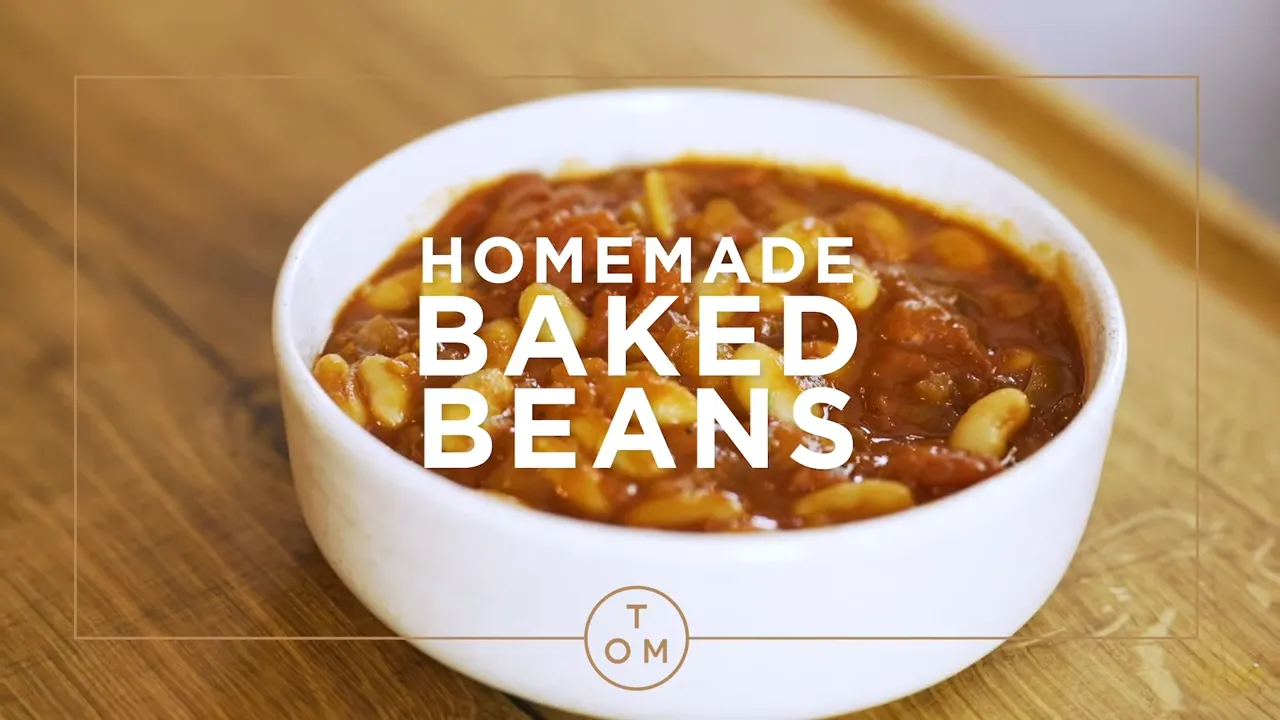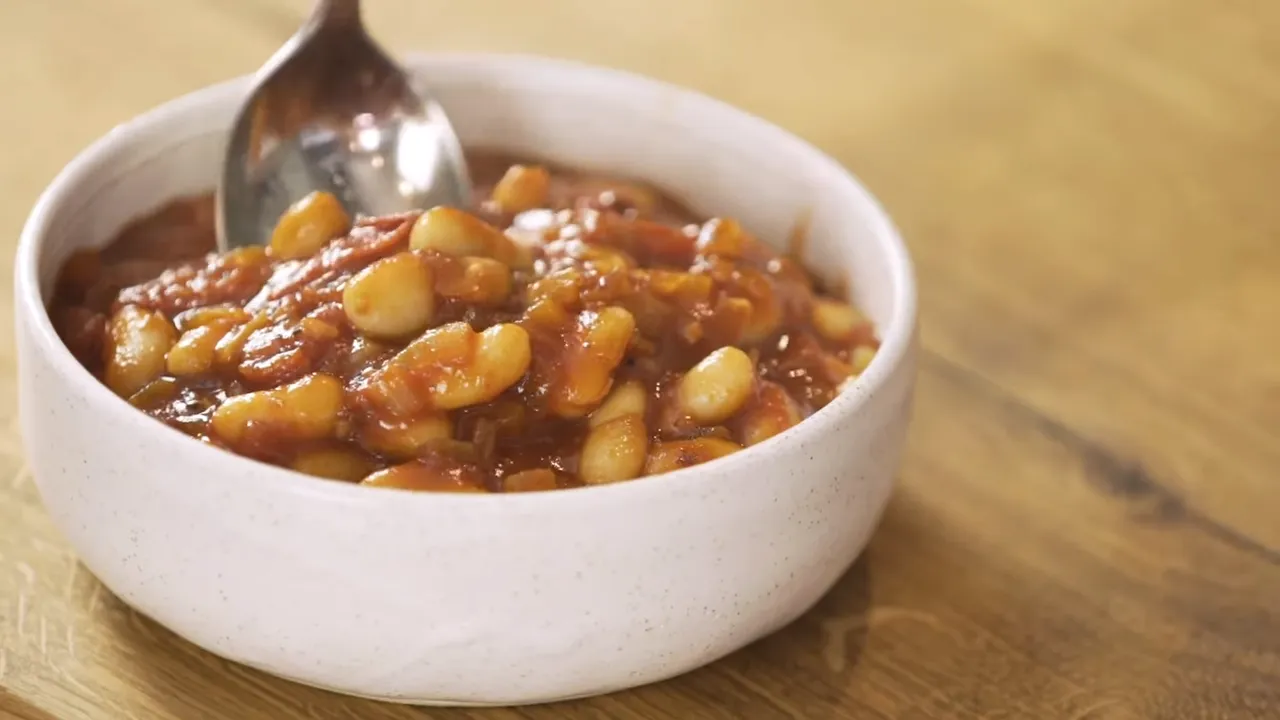When it comes to comfort food, few dishes deliver like a classic baked beans recipe. Whether spooned beside barbecue ribs or piled on toast, baked beans bring warm, saucy satisfaction with every bite. This guide walks you through the best baked beans recipe that balances sweetness, smokiness, and a whisper of spice. You’ll learn what beans to use, how to bake them just right, and how to add bold flavor using pantry staples. Along the way, we’ll answer common questions about health, origin, and technique, and link to even more savory side dishes like hot honey biscuits and seafood boil sauce.
Table of Contents
From Sweet Memories to Smoky Pots of Baked Beans
The Flavor Story Behind This Baked Beans Recipe

Baked Beans Recipe
Ingredients
Equipment
Method
- Preheat oven to 325°F (163°C). In a Dutch oven, cook chopped bacon until crispy. Remove with slotted spoon and set aside.
- Add diced onion to bacon fat and sauté until soft. Stir in garlic, tomato paste, and paprika; cook 1 minute.
- Add vinegar, brown sugar, molasses, mustard, Worcestershire, and water. Simmer for 5 minutes to thicken slightly.
- Stir in cooked navy beans and reserved bacon. Transfer uncovered to oven and bake for 2 to 2.5 hours, stirring occasionally.
- Let cool 10 minutes before serving. Sauce will thicken as it rests.
Notes
I’m Ava Rynolds, and this baked beans recipe takes me right back to the scent of Grandma’s back porch in Louisiana. Picture a cast-iron Dutch oven bubbling away while the crickets hum and someone’s cousin yells out, “Beans smellin’ ready yet?” My summers were shaped by food that made you wait—and rewarded your patience. Grandma layered molasses, mustard, and bacon like a melody. Back in Atlanta, Mom swapped the spice for honey. And me? I found balance. One bite of these beans—sweet, smoky, swicy—and you’ll get why I call them “a porch memory in every spoon.”
My love for contrast—sugar meeting spice—started here. I once added leftover crawfish to sweet baked beans at age six. The whole family reached for seconds. From that moment, I was hooked on playing with flavor. That curiosity led to this dish you’ll make today. It’s not just a side—it’s a centerpiece.
Why This Baked Beans Recipe Stands Out
This isn’t your average canned beans dump-and-bake. We slow cook navy beans in a sauce built from layers: real brown sugar, smoky paprika, sharp Dijon, tangy apple cider vinegar, and thick-cut bacon. The result? Beans that are tender but not mushy, with a glaze that clings like barbecue sauce.
Even better, this recipe is make-ahead friendly and reheats like a dream. It’s ideal for cookouts alongside hot honey wings or ladled over buttery hot honey biscuits.
Coming up, we’ll break down what beans to use, how long to cook them, and how to make them vegetarian without losing flavor.

Choosing Beans and Building the Base
What Type of Beans Are Best for Baked Beans?
When someone asks “What type of beans are baked beans?”—the answer is almost always navy beans. Small, mild, and perfectly starchy, they soak up all the flavor without going mushy. Pinto beans can work too, especially if you like a softer texture. Cannellini beans are meatier and give a slightly richer bite, but they’re less traditional. Black beans or kidney beans? Save those for chili. If you want that classic taste and appearance—stick with navy beans.
Start with dried beans if you’ve got time. Soak them overnight, boil until barely tender, then bake them low and slow in sauce. But if you’re in a hurry, canned navy beans (rinsed and drained) work beautifully for a quicker dish.
Baked Beans Start with the Sauce
No great baked beans recipe starts with just beans—it starts with sauce. This one builds a deep flavor base in a saucepan before baking.
First, fry up some chopped bacon until the fat renders and the edges go crisp. Toss in diced onions and sauté until translucent, letting them soak in the bacon flavor. Then stir in garlic, tomato paste, and smoked paprika to bloom the spices. Deglaze with apple cider vinegar, then stir in brown sugar, molasses, Dijon mustard, Worcestershire sauce, and a splash of water.
Let that mixture simmer until it thickens and smells irresistible. That’s your flavor engine right there.
If you want to go vegetarian, skip the bacon and use smoked paprika generously. You can also stir in a spoonful of miso paste or soy sauce to add umami.

From there, it’s all about gently folding in your navy beans and letting them soak up that sauce in a low oven—or even your slow cooker.
Speaking of flavor layering, this base sauce also works beautifully as a glaze for proteins like honey sriracha tofu.
Baking to Perfection – Low and Slow Wins (300 words)
How Do You Make Baked Beans Taste Like They Cooked All Day?
Whether you start from dried or canned beans, baked beans thrive with patience. If you’re wondering how to make baked beans taste rich and smoky without simmering all day—here’s the trick: bake them uncovered at a low temperature. This helps the sauce reduce, caramelize slightly, and cling to every bean.
Preheat your oven to 325°F. After mixing your beans and sauce, pour everything into a cast iron Dutch oven or a deep ceramic dish. If the sauce looks too thick before baking, add a splash of water or stock to keep things from drying out too fast.
Bake uncovered for 2 to 2.5 hours if using canned beans—longer if starting from dried. Stir once or twice, gently scraping the bottom to avoid sticking. When done, the sauce will be thickened and sticky in the best way, and the top will have formed a slight crust. That crust? That’s flavor gold.
You can also make this recipe in a slow cooker. Just pour everything in and cook on low for 6–8 hours. It won’t caramelize quite the same, but it’ll still taste amazing.
Make-Ahead and Reheating Tips

The beauty of baked beans is that they taste even better the next day. Make a batch the day before your cookout, cool completely, and store in an airtight container. Reheat gently on the stovetop or in a 300°F oven, adding a splash of water to loosen the sauce.
Got leftovers? Spoon them next to chuck roast or even layer them in a breakfast bowl with fried eggs.
And if you want to double the batch? Go for it. These beans freeze beautifully for up to 3 months—just defrost overnight and reheat low and slow.
Digging Deeper – Origins, Health, and FAQs (300 words)
Why Are They Called Baked Beans?
The name baked beans dates back to colonial America, though the roots go even deeper—to Native American cooking traditions. Early bean dishes were simmered with maple syrup and bear fat or game meats, and settlers adapted the technique using molasses and salt pork. Boston became famous for its “Boston Baked Beans,” cooked low and slow in brick ovens overnight, giving the dish its signature caramelized top and deep flavor.
Despite the rise of canned beans, the heart of the dish hasn’t changed: slow-baked legumes in a sweet-savory sauce. Even modern spins, like my own swicy take, stay true to the slow-cooked soul of the original.
Baking creates the magic that stovetop simmering can’t—an oven allows sugars to thicken and develop into a deep, sticky glaze. That’s what turns this humble side dish into a family favorite worth savoring.
Are Baked Beans Healthy to Eat?
Yes—baked beans can absolutely be part of a healthy meal, especially when made from scratch. Beans are high in fiber, protein, and essential minerals like iron and magnesium. They help stabilize blood sugar and support gut health.
Canned versions, however, can be loaded with added sugars and sodium. That’s why this homemade baked beans recipe gives you full control. You can cut the sugar, reduce the salt, and even skip the bacon if you’re watching saturated fats.
Want to make them lighter? Use a tablespoon of olive oil instead of bacon, swap brown sugar for maple syrup, and add diced vegetables like carrots or bell peppers.
Even better, pair your beans with lean proteins or plant-based dishes. Try serving them next to seafood boil or spooned over quinoa and roasted veggies for a fiber-packed vegetarian dinner.
Now, let’s run through four top questions people ask before they make baked beans at home. These answers will help you master your pot every single time.
Conclusion: A Side Dish That Steals the Show
Baked beans aren’t just a cookout side—they’re a story, a tradition, and a flavor memory in every bite. When you make them from scratch, you get to shape every spoonful. Whether you keep it classic with molasses and bacon or add a modern swicy twist like I do, this baked beans recipe is the kind of dish that gets scraped clean and asked for again.
Pair it with buttery hot honey biscuits or alongside slow-roasted chuck roast. And don’t be surprised if these beans become the most requested dish at your next barbecue.
Because when comfort meets flavor like this, it doesn’t play second fiddle—it takes center stage.
For more recipes folow us in Facebook and Pinterest

FAQs
Are baked beans healthy to eat?
Yes. When made from scratch, baked beans are rich in fiber, protein, and minerals. Control added sugar and salt for a more balanced dish.
How do you make baked beans?
Sauté aromatics, add sweet and tangy ingredients like molasses and mustard, stir in cooked beans, then bake uncovered until thick and glazed.
What type of beans are baked beans?
Navy beans are traditional, but pinto or cannellini beans work too. Navy beans soak up flavor and keep their shape.
Why are they called baked beans?
The dish originated from early American cooking, where beans were baked slowly in ovens with sweeteners and meat—hence the name “baked.”
